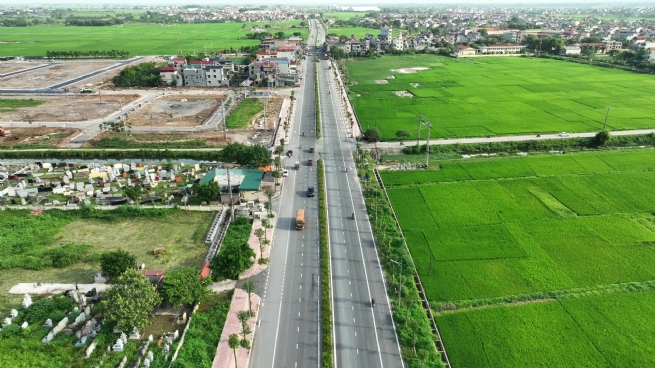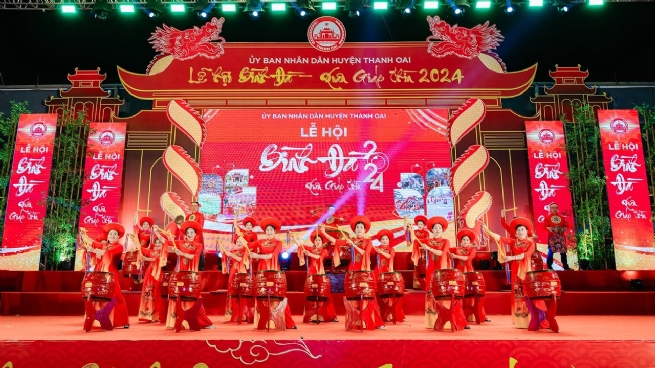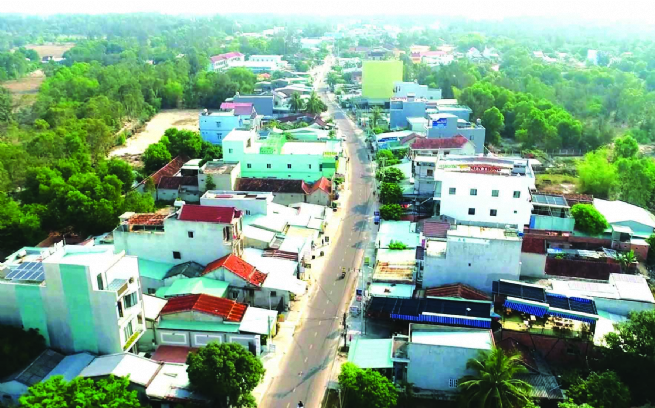Located at the southwestern gateway of the capital, Binh Minh occupies a strategic position where key transportation routes intersect, including Ring Road 4 - Capital Region, National Highway 21B, and roads linking neighboring communes. This location not only supports the development of urban-service infrastructure but also positions Binh Minh as a central hub driving development in southern Hanoi.

The commune is shifting its agriculture toward ecological, organic, and high-tech models
In the master plan for the capital’s development to 2045, with a vision to 2065, Binh Minh is designated as a new driving area - both a modern urban zone and an ecological, cultural buffer. With coordinated planning, Binh Minh will become a hub of commerce, services, and clean industry, integrated with cultural tourism and craft villages, preserving traditional values such as the Binh Da Festival and handicraft villages while creating a green, civilized, and modern living environment. Positioning Binh Minh as a connectivity and spillover hub will allow the commune not only to maximize internal potential but also to lead the development of surrounding areas. At the same time, rapid urbanization brings environmental, infrastructure, and public security pressures, posing significant challenges that require decisive, creative, and resilient action from the Party, authorities, and local residents.
Binh Minh, with nearly 30 square kilometers and a population of over 80,000, combines a strong agricultural base with diverse craft villages, creating a unique identity and opportunities for sustainable rural development. To address the limitations of small-scale farming, the commune is restructuring agriculture toward ecological, organic, and high-tech models linked with craft villages, thereby preserving cultural identity, improving the living environment, and building a distinctive socio-economic foundation.
According to Nguyen Dang Viet, Chairman of the People’s Committee of Binh Minh Commune, with more than 1,567 hectares of agricultural land accounting for more than half of its natural area, Binh Minh has favorable conditions to form specialized zones for vegetables, fruits, flowers, and ornamental plants. These will provide the basis for branded products that meet the growing demands of Hanoi and neighboring markets.

Binh Da festival 2024
With these advantages, the commune’s priority is to develop ecological and organic agriculture that ensures food safety while protecting the environment and local ecosystems. Vu Xuan Loc, Head of the Binh Minh Economic Department, noted that the commune will closely follow planning and leverage land resources to expand models of clean vegetable cultivation, flowers and ornamental plants, and high-quality fruit production, linked with brand building, product traceability, and consumer trust.
In addition to crop cultivation, livestock farming is also being restructured toward farm-scale operations, with the application of biosecurity processes and waste treatment technology. This is a crucial step to address environmental pollution while enhancing added value in animal husbandry. All livestock zones will be relocated outside residential areas.
If agriculture is the foundation, craft villages are the driving force for Binh Minh’s rural economic upgrading. Nguyen Dang Viet emphasized that the commune Party’s Resolution has clearly identified: from 2025-2030, industrial and handicraft development in Binh Minh must be closely tied to preserving and enhancing craft village values. This is not only the livelihood of tens of thousands of workers but also the link connecting agriculture with processing industries and trade-services.

The commune’s landscape has improved significantly
The commune currently has 13 recognized traditional craft villages, many closely linked to agricultural processing. This provides a unique advantage for Binh Minh to develop an integrated model of “agriculture, craft villages and services.” Craft villages specializing in agricultural processing, handicrafts, and traditional materials have already created a distinctive identity for the area.
In the next phase, the commune aims to expand scale, apply new technology, and improve product quality, gradually reaching export standards. This will not only increase residents’ incomes but also create a closed value chain from ecological agricultural production, processing and consumption through craft villages, to connection with trade and services. “To support this process, Binh Minh also plans to establish two concentrated industrial clusters, relocating small-scale production facilities out of residential areas. This step both promotes craft village strengths and creates a clean, modern, and civilized living environment for residents,” Nguyen Dang Viet said.
By linking ecological agriculture with craft villages, Binh Minh will form a distinctive economic-cultural space. Here, farmers not only produce but also participate in a broader value chain: producing clean products, developing experiential tourism models, maintaining traditional crafts while upgrading technology. In the context of Hanoi’s urban expansion, many communes face major challenges - either losing identity in the wave of urbanization or seeking ways to leverage their strengths. Binh Minh has charted the right path in today’s development trend, taking ecological agriculture as its foundation, craft villages as its driver, and green urban planning as its vision. This synergy will help Binh Minh grow rapidly, sustainably, and with distinct identity.
By Bao Dan, Vietnam Business Forum
| This special section is supported by Hanoi Coordination Office of the New Rural Development Program |